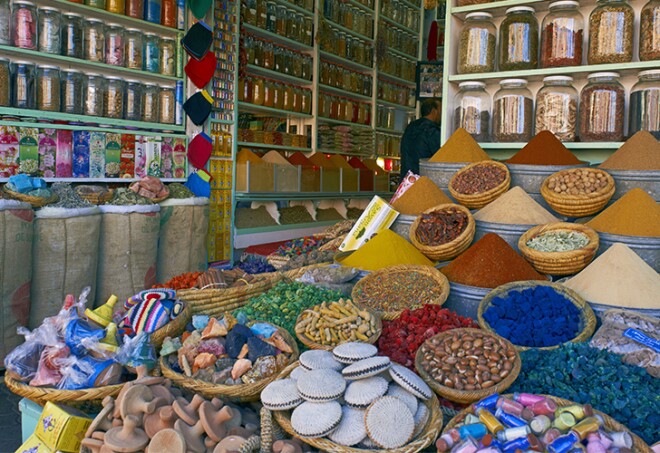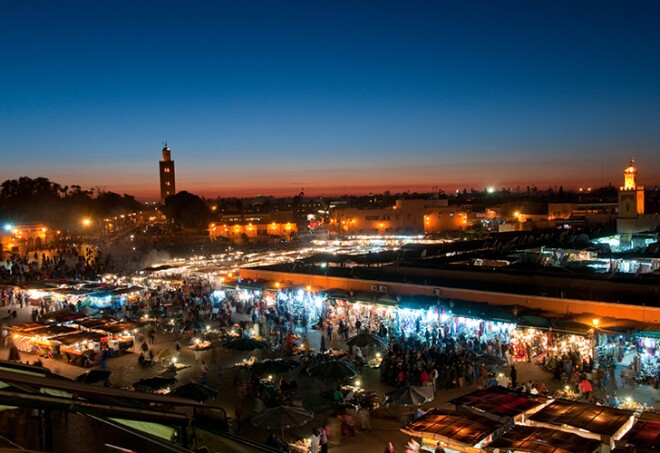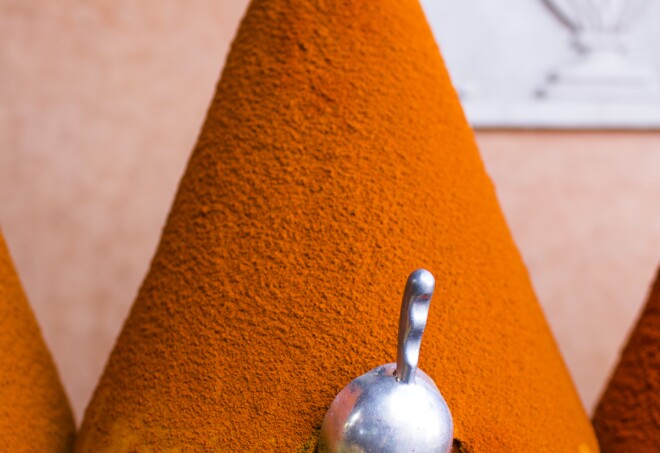The Perfect Day in Marrakech
Marrakech may not be the largest city in the world--it’s not even the largest city in Morocco. But Marrakech offers so much to see, do, eat, and shop that it feels as though it’s a country all its own. Focus, mostly, on the medina quarter. Power your day on the mint tea you can find pretty much everywhere. Within the medina, find traditional Moroccan food, 14th century buildings, the Koutoubia mosque, and, yes, some snake charmers too. Leave the medina for the Yves Saint Laurent museum and house. But be back around dusk to eat your way through the food stalls at Jemaa El Fna.
Marrakesh, Morocco
Inscribed above the door of the Ben Youssef Medersa in Marrakech reads the following: “You Who Enter My Door May Your Highest Hopes Be Exceeded.” It is an appropriate proclamation for what is arguably the most mind-blowing example of Islamic design and architecture within a Koranic school anywhere in the country. Founded in the 14th century, it was embellished by the Saadian dynasty in 1570 with an ornate bronze doorway, elegant stuccoes, and a marble-tiled patio lined with elaborate mosaics. The prayer room, with its palm and pine cone motifs, looks down into the courtyard from the students’ quarters and gives a splendid helicopter view of the space. During its heyday, the medersa had room for up to 900 students; it was given over to the city as a museum in the 1960s and has remained so ever since.
Marrakech Les Jardin De La Menara، Marrakech 40000, Morocco
Declared a UNESCO World Heritage site in 1985, the Jardin Menara was created in the mid-12th century by the Almohad dynasty. Since then, its gardens have been added to and embellished by varying degrees for other sultans but always centered around a huge, flat reflecting pool, which captures the Atlas Mountains in the most sensational way on a clear day and forms the focus of a space that covers nearly 250 acres. An elegant pavilion was installed during the Saadian rule of the 18th century and proved a popular summer escape from the heat among city dignitaries. Unlike other, more formal gardens of the city, Menara’s vast olive groves, orange orchards, and cypresses feel more natural and create a true escape from the fray. Although extremely popular with picnicking Moroccan families in the afternoons, the place is blessedly free of tourists and a lovely, peaceful place for a stroll.
75 Derb Rahba Lakdima, Marrakech 40000, Morocco
If the Djemaa el Fna is the epicenter of Marrakech, the Rahba Lakdima—otherwise known as the Place des Épices, or Spice Traders Square—is surely the epicenter of the medina itself. Bursting with rambunctious energy and high-voltage color, the market is lined on one side by mysterious herbalists and spice traders selling everything from snakeskins to rose petals to ras el hanout (the famous Moroccan spice blend), and by carpet sellers on the other. Venture to the latter’s lair around 4 p.m. when sellers come down from the mountain villages, and you’ll be treated to the spectacle of them plying their trade with the professionals. And in the middle, heaps of woven baskets and woolen skullcaps are piled high. There’s no better place to sit and watch this daily theater unfold than at the Café des Épices, the first of several that have now opened there, but still our favorite for excellent coffee, fresh salads, sandwiches, and tagines.
Rue Bin Lafnadek
This delightful gallery is housed in one of Marrakech‘s elegant Saadian town houses, all creamy white plaster walls and subtle bejmat (unglazed terra-cotta) tiled floors. It’s the perfect setting for what began as owner-creators Hamid Mergani and Patrick Manac’h’s private and extensive collection of photographs that document scenes and portraits of Moroccan life over the past century. Today the foundation encompasses a whole lot more, with numerous collectors and photographers such as Daniel Chicault, Ana Muller, and Jean-Pierre Évrard donating or loaning from their own collections. There’s also a terrific little café on the roof for traditional Berber cooking and splendid views of the Atlas Mountains.
Rue Yves St Laurent, Marrakech 40000, Morocco
Constructed by Studio KO architects to echo the weave of fine cloth, the Yves Saint Laurent Museum opened in late 2017 to great fanfare. It was particularly poignant because Pierre Bergé, the longtime partner and business head behind the late designer, had died less than a month earlier. No doubt he would have been delighted with what he saw, for the museum is a game changer with its fresh approach to documenting a subject. Many of Saint Laurent’s lauded haute couture prototypes are on display here against a sleek black backdrop, which makes them appear to almost float across the room, and the library is one of the best in the world on the subject of fashion. A separate auditorium hosts seminars, film screenings, and other events, and the café—simply called Le Studio—has become the lunch favorite of the city’s glitterati. Saint Laurent, you can’t help but feel, would have approved.
Passage Prince Moulay Rachid
Described by writer Tahir Shah as the “greatest show on Earth,” no visit to Marrakech would be complete without a visit to the famous night market on the Djemaa el Fna. Arrive before sunset and park yourself at one of the various cafés with terraces overlooking the square to watch performers set up; then venture into the fray in search of adventure. Silk-clad acrobats, wide-eyed storytellers, sly snake charmers, jangling belly dancers, and capricious monkey handlers all emerge from the darkness, ringing the edge of the food stalls with their own special brand of entertainment. When you tire of the heckling, prowl the market in search of good things to eat: bite-size morsels of grilled lamb rubbed in cumin, sardines fried in chermoula, peppery snails, and sheep’s heads for the brave. Then nudge up alongside a family of locals at the table and settle in for the feast. If you’re nervous about going it alone, you can sign up for a food tour with Canadian tour guide and all-round good egg Mandy Sinclair of Tasting Marrakech; she’ll help you find the best stalls while introducing you to the secrets and delights of traditional Moroccan street food.
Médina, Marrakesh 40000, Morocco
“The Medina is like Brooklyn in that there are all sorts of neighborhoods within it. The Old Jewish Quarter is still a very local place. It feels like Marrakech 30 years ago—a bit rugged and run-down, but it’s cool to wander around in. There are a bunch of shops selling herbs and spices and crafts such as jewelry.”-Moroccan artist Hassan Hajjaj This appeared in the August/September 2014 issue.
1 Derb Aarjane, Marrakesh 40000, Morocco
A stalwart on the medina dining scene for several years now, Nomad has fabulous views of bustling Place des Épices and takes a bold, creative approach to Moroccan dining. The yellow-and-black ‘60s-inspired space has several dining areas and rooftop terraces, which make lingering over lunch or dinner a joy; the food is a lighter, brighter take on local cooking that plays with traditional flavors and elevates them into something fresh and exciting. To start, try their delicately spiced Moroccan gazpacho or a shaved cauliflower and fennel salad scattered with toasted almonds; perhaps followed by a hearty plate of roasted bone marrow scattered with preserved lemons, cumin, and mint; then finishing with a hibiscus-infused panna cotta. Alcohol isn’t served here, but with food this enticing, you won’t miss it.
The gallery, boutique, and tearooms of Morocco’s most famous living artist, Hassan Hajjaj, is an essential stop for any art lovers staying in the city. Tucked away down a narrow alley behind the Rahba Lakdima (otherwise known as the Place des Épices), it’s like stumbling into a jewel box filled with pop-art treasures. Hajjaj made a name for himself with a series of photographs titled Kech Angels, which depicted local girls on mopeds dressed in eye-popping robes. The collection has been exhibited all over the world in such illustrious venues as the Victoria and Albert Museum in London and the Institut des Cultures d’Islam in Paris, but nowhere beats enjoying the work on home turf. While you’re there, treat yourself to his iconic recycled home and fashion pieces, such as a sardine-can lantern, a pair of babouches (Moroccan slippers) cut from a flour sack, or a stool from an oil drum. And if you hang around for a pot of mint tea in the courtyard, you might even meet the man himself.


















